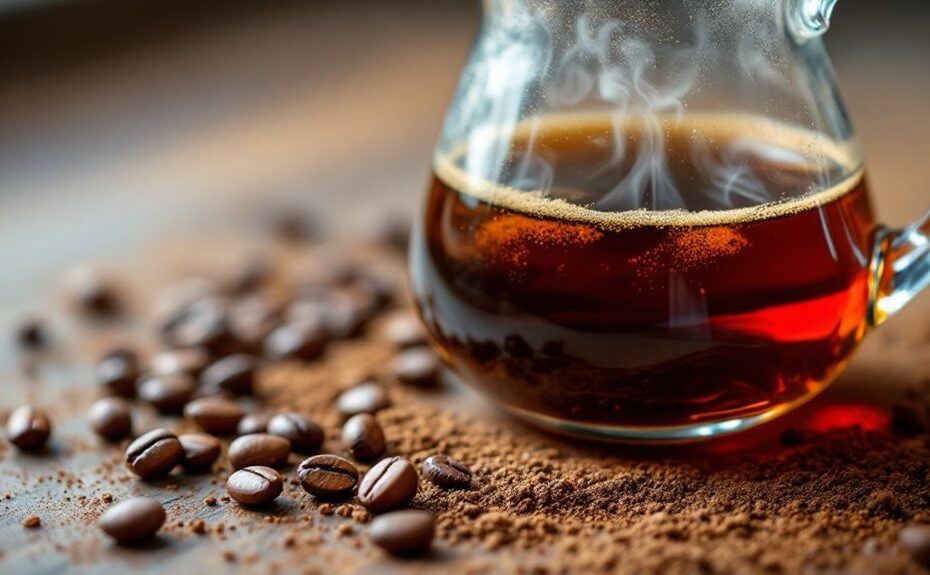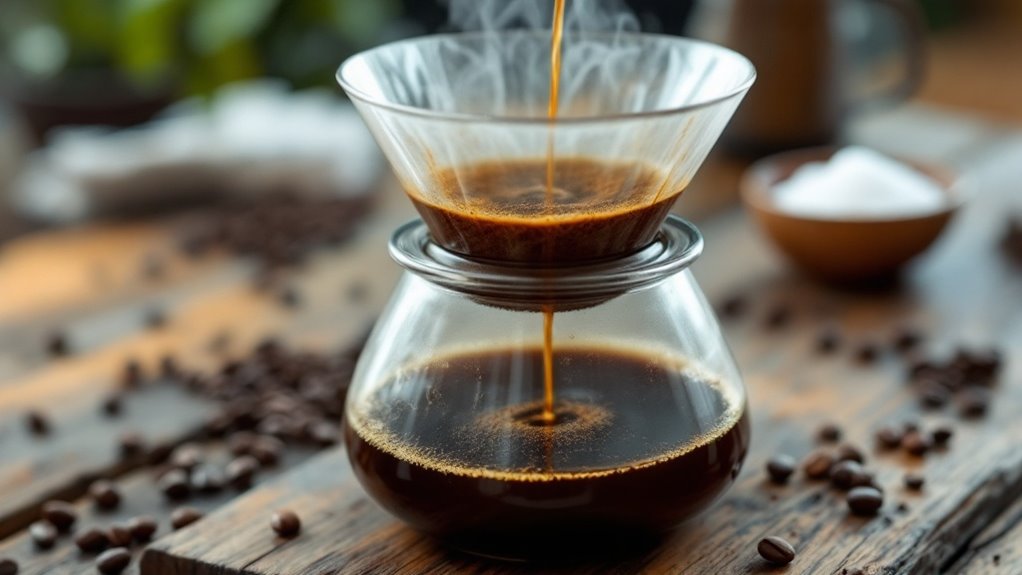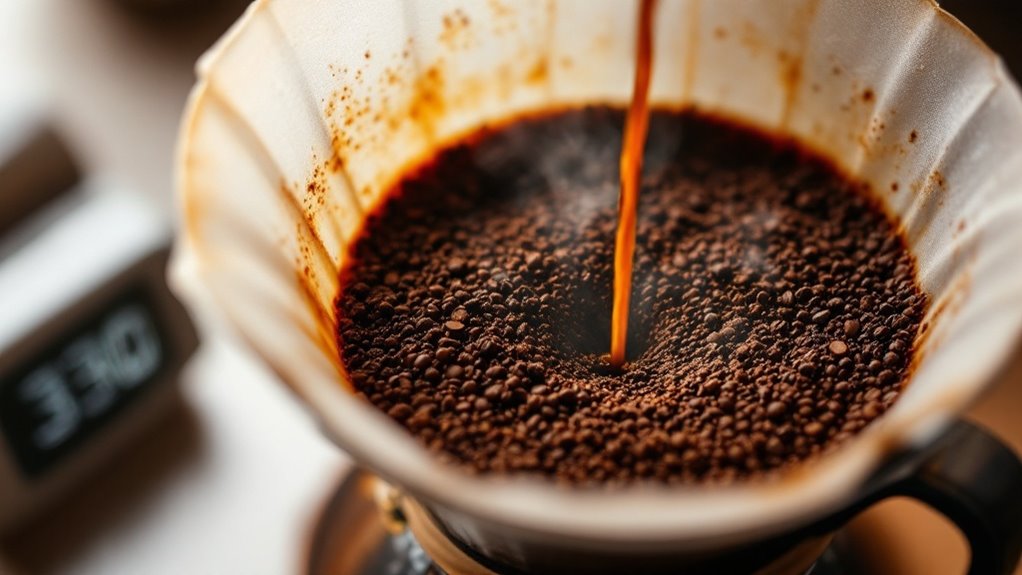







Over 1 billion cups of coffee are consumed daily worldwide, but have you ever wondered what makes your morning brew so complex? The chemistry of coffee involves hundreds of compounds, from caffeine to chlorogenic acids, that shape its flavor, aroma, and even its effects on your body. Roasting and brewing transform these compounds, creating the balance of bitterness, acidity, and sweetness you taste. Yet, the science behind why water temperature or grind size changes your cup remains a mystery to most. What exactly happens when heat meets a coffee bean, and how does it all come together in your mug?
Key Takeaways
- Coffee contains caffeine, tannins, fixed oils, proteins, and chlorogenic acids, which influence flavor, aroma, and health benefits.
- Caffeine blocks adenosine receptors, enhancing alertness and mood, while affecting sleep patterns if consumed excessively.
- Over 1,000 aromatic compounds, including pyrazines and methional, create coffee's complex flavor profile, varying with roast levels.
- Roasting triggers Maillard reactions and caramelization, reducing water content and forming melanoidins, which give coffee its color and flavor.
- Brewing chemistry depends on water quality, temperature, and extraction rates, balancing acidity, bitterness, and overall flavor in the final cup.
Chemical Composition of Coffee Beans
The chemical composition of coffee beans is a complex interplay of organic compounds that define their flavor, aroma, and physiological effects. Coffee beans contain a diverse array of substances, including 2-3% caffeine, 3-5% tannins, 10-15% fixed oils, and 13% proteins, all contributing to their intricate chemical profile. Chlorogenic acids (CGA), which make up to 14% of green coffee beans, are particularly significant. These phenolic compounds not only influence the bitterness and astringency of coffee but also provide potent antioxidant properties, which can impact your health. Carbohydrates, such as insoluble polysaccharides like cellulose, mannose, galactose, and arabinose, contribute to the texture and mouthfeel of brewed coffee. Lipids, including linoleic acid, palmitic acid, triacylglycerols, and diterpenes, play a role in the formation of crema in espresso and affect the overall sensory experience. Additionally, coffee beans contain volatile acids like formic and acetic acids, as well as nonvolatile acids such as lactic, tartaric, and citric acids, which shape the acidity and flavor balance. Understanding the chemical composition of coffee helps you appreciate how these compounds interact to create the beverage's unique characteristics.
The Role of Caffeine in Coffee
In coffee, caffeine (C8H10N4O2) plays a central role in shaping both the sensory and physiological effects of the beverage. Found in coffee beans at concentrations ranging from 0.6% to 4%, caffeine contributes to the bitterness, strength, and body of your brew. Its chemical composition, a xanthine alkaloid, guarantees it remains stable during roasting, preserving its potency regardless of the roast level. When you consume coffee, caffeine blocks adenosine receptors in your brain, preventing the binding of adenosine, a neurotransmitter that promotes drowsiness. This inhibition triggers the release of adrenaline, heightening alertness and focus. Additionally, caffeine indirectly activates dopamine receptors, enhancing mood and cognitive performance. However, excessive intake can disrupt melatonin production, altering your sleep patterns and circadian rhythms. The chemical composition of caffeine also influences its solubility, allowing it to dissolve efficiently in water during brewing, securing its presence in every cup. By understanding caffeine's role, you gain insight into how coffee beans transform into a beverage that not only stimulates your senses but also impacts your physiology.
Aromatic Compounds and Flavor Profiles
Hundreds of aromatic compounds work together to create coffee's intricate flavor and aroma, each contributing unique sensory characteristics. Pyrazines, for instance, impart earthy notes, while methylpropanol introduces fruity or spicy undertones. Chlorogenic acids (CGA), which constitute about 8% of unroasted coffee beans, play a pivotal role in shaping bitterness. During roasting, these acids break down into lactones and phenylindanes, which dominate the bitter flavor profiles in roasted coffee. Light to medium roasts feature lactones like 3-caffeoylquinic-1,5-lactone and 4-caffeoylquinic-1,5-lactone, while dark roasts exhibit harsher bitterness due to higher concentrations of phenylindanes.
Methional adds a baked potato-like scent, and methanethiol contributes a cabbage or garlic-like odor, both enhancing the complexity of coffee's aroma. These compounds, alongside over 1,000 others, create a symphony of flavors that define coffee's sensory experience. The interplay of chlorogenic acids and their derivatives guarantees that each roast level delivers distinct flavor profiles, from the nuanced bitterness of lighter roasts to the robust, intense bitterness of darker ones. Understanding these aromatic compounds helps you appreciate the chemistry behind coffee's diverse and enthralling taste.
The Chemistry of Coffee Roasting
As green coffee beans undergo roasting, they transform through a series of complex chemical reactions, primarily driven by the Maillard reaction and caramelization. These processes break down sugars and amino acids, creating the rich flavors and aromas characteristic of roasted coffee. During roasting, water content drops from 65% to 10%, concentrating the beans and releasing volatile compounds that enhance their sensory profile. Chlorogenic acid lactones form in light to medium roasts, contributing to bitterness, while phenylindanes dominate in dark roasts, intensifying the bitter notes. As temperatures rise to 240°C, carbon dioxide escapes, causing the beans to expand and sometimes burst. The Maillard reaction produces melanoidins, which give coffee its brown color and complex flavor. Caramelization further breaks down sugars, adding sweetness and depth. Ideal roasting balances these chemical reactions to achieve desired flavors; under-roasting leaves the coffee overly acidic, while over-roasting increases bitterness and reduces complexity. Each roast level—light, medium, or dark—unlocks distinct chemical changes, shaping the final cup. Understanding these processes allows you to appreciate how roasting transforms raw, green beans into the aromatic, flavorful coffee you enjoy.
Brewing Chemistry and Water Quality
Water quality and chemistry play a pivotal role in shaping the flavor and quality of your brewed coffee. The composition of coffee relies heavily on the chemical components extracted during brewing, which are influenced by water's mineral content and pH. Soft water, low in calcium and bicarbonate, enhances acidity, while hard water, rich in bicarbonate, can impart a chalky taste. For ideal extraction, your water should have a balanced pH and mineral profile to avoid masking or distorting the coffee's natural flavors.
The temperature of your brewing water (90-96°C) determines the solubility of key compounds like caffeine and chlorogenic acids, affecting the brew's strength and bitterness. Particle size distribution of your coffee grounds and the brewing method (e.g., French press, drip) also dictate extraction rates. Diffusion during brewing allows water to dissolve soluble compounds from the grounds. Over-extraction leads to bitter flavors, while under-extraction results in sourness. By controlling these variables, you can fine-tune the chemical components of coffee to achieve a balanced and flavorful cup. Understanding the interplay between water chemistry and brewing parameters guarantees you extract the full potential of your coffee's composition.
Disclosure: As an Amazon Associate, I earn from qualifying purchases.




